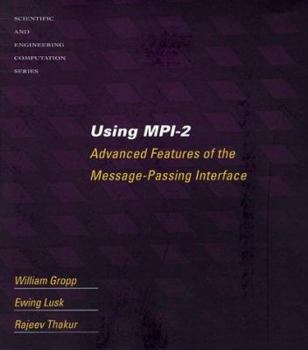Using Mpi-2: Advanced Features of the Message-Passing Interface
(Part of the Scientific and Engineering Computation Series and Scientific and Engineering Computation Series Series)
Using MPI is a completely up-to-date version of the authors' 1994 introduction to the core functions of MPI. It adds material onthe new C++ and Fortran 90 bindings for MPI throughout the book. The Message Passing Interface (MPI) specification is widely used for solving significant scientific and engineering problems on parallel computers. There exist more than a dozen implementations on computer platforms ranging from IBM SP-2 supercomputers to clusters...
Format:Paperback
Language:English
ISBN:0262571331
ISBN13:9780262571333
Release Date:November 1999
Publisher:MIT Press
Length:382 Pages
Weight:1.95 lbs.
Dimensions:0.8" x 8.2" x 8.9"
Age Range:18 years and up
Grade Range:Postsecondary and higher
Customer Reviews
3 ratings
Pretty good for MPI Beginners.
Published by Thriftbooks.com User , 16 years ago
I bought this book for a course on Parallel Computing for which we did some basic MPI programming. This book was useful to a great extent in describing the syntax of the MPI routines as well as in providing ample examples. To my knowledge, it doesn't contain advanced MPI concepts but it is good in explaining the basics of MPI if you are a beginner.
Thorough coverage of MPI programming in Fortran, C, and C++
Published by Thriftbooks.com User , 18 years ago
This book is an excellent introduction to programming with the MPI. It gradually introduces concepts from the simple to the complex. This is done with examples that illustrate the use of different techniques. The examples include the code to implement them. The programming examples alternate between Fortran 90, C, and C++. However, after giving the example in one language, the bindings for the MPI functions in the other two languages are presented. In addition, the programming examples in either language are easily understood. Although my first choice of programming language is Fortran (and I have very basic knowledge or C), I was able to follow the examples in C and C++ and to write their equivalents in Fortran so I could test them on our computers.
good reference but short on C examples
Published by Thriftbooks.com User , 24 years ago
I liked the reference as an introduction to MPI, but it switched between fortran and C so often that I spent a fair amount of my time just trying to interpret the code samples and synchronize to the syntax of the language they were using. You shouldnt have that problem if you have used Fortran in the last ten years but i havnt touched it since college. You have to be able to work with both languages though because many of the key concepts are only demonstrated in one language. Also the examples were usaully spread out into mini snipets as opposed to a larger block that might show a more complete picture.






